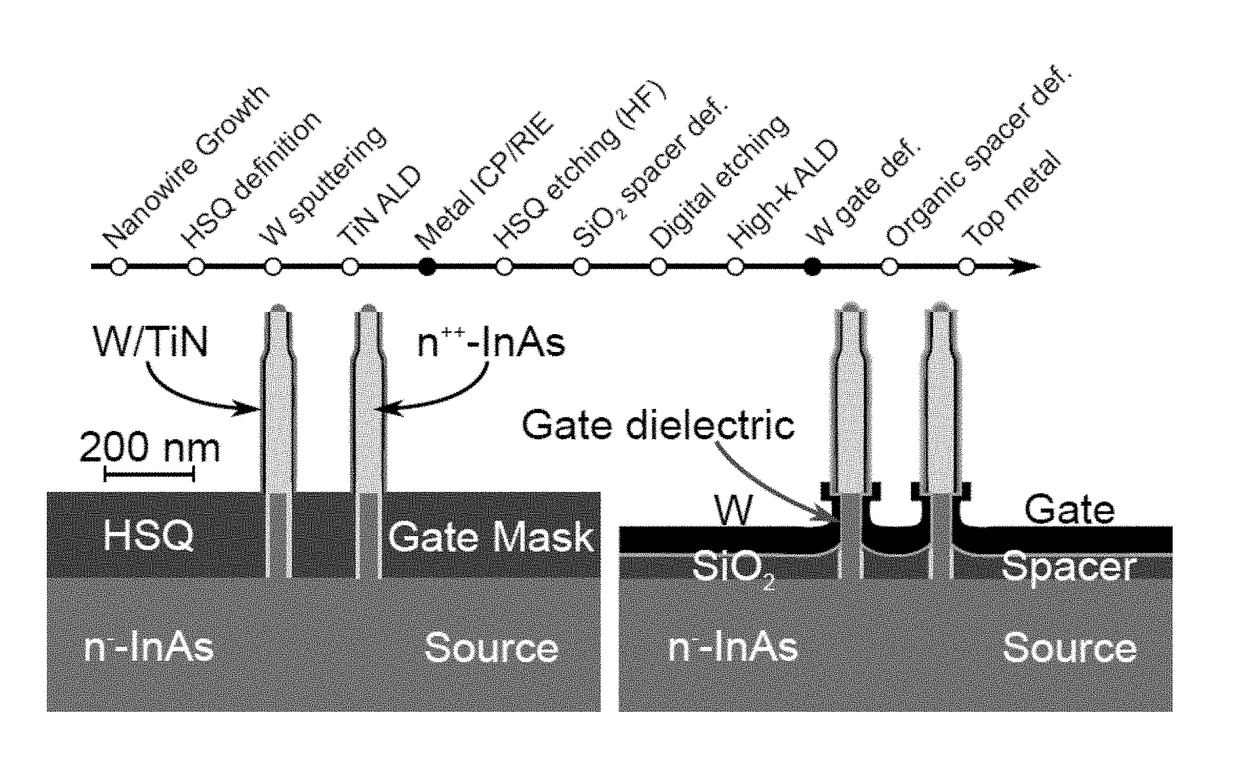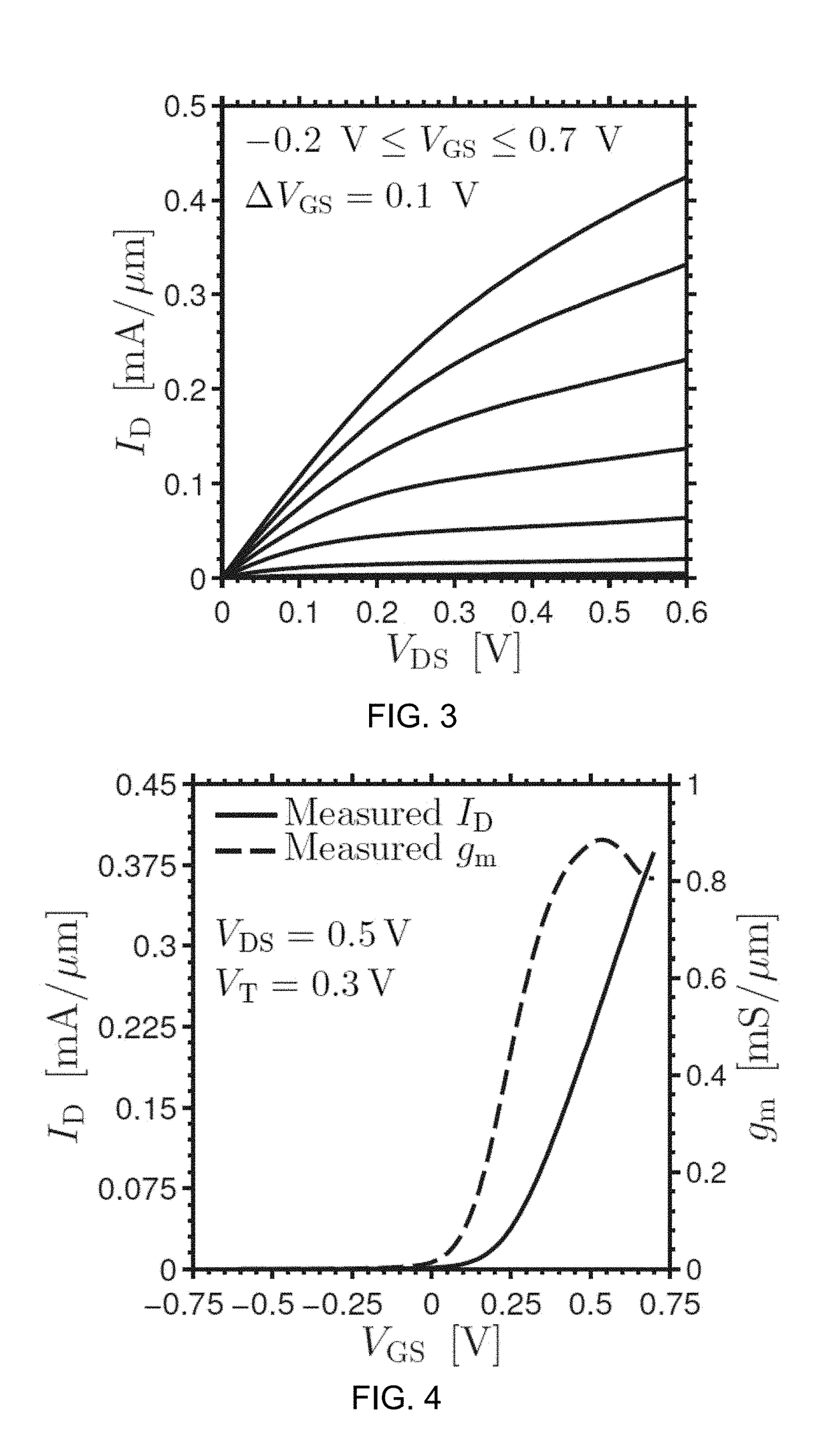Method for vertical gate-last process
a technology of metal oxides and transistors, applied in the direction of semiconductor devices, electrical equipment, nanotechnology, etc., can solve the problems of high-precision doping control along the axial direction of the nanowire, which has proved insufficient and is very challenging
- Summary
- Abstract
- Description
- Claims
- Application Information
AI Technical Summary
Benefits of technology
Problems solved by technology
Method used
Image
Examples
first embodiment
[0021]In the present invention, the upper ohmic transistor electrode is formed prior to the gate formation.
[0022]In a first step, the bottom of the nanowires is protected by one or several organic or inorganic layers, such as Hydrogen silsesquioxane (HSQ), SiNx, SiO2, BCB, photoresists. To achieve gate length control, the layer thickness is controlled around each nanowire, for instance via the control of the exposure dose or by local thinning of the layer by etching or by local addition of material by deposition. A top metal contact is formed by metal deposition, such as sputtering of 20 nm W and atomic layer deposition (ALD) of 5 nm TiN, or deposition of Ni. This metal is etched anisotropically for instance by dry etching, removing the planar layer and only keeping the metal on the nanowire sidewalls. The protection layer is then removed.
[0023]In a second step, an organic or inorganic spacer layer, such as SiO2, is deposited where the thickness of this layer is thinner than the fir...
second embodiment
[0027]In a second embodiment, the upper ohmic transistor electrode is formed prior to the gate formation.
[0028]In a first step, an ohmic contact is deposited below the gate region of the transistors.
[0029]In a second step, the region above the bottom ohmic contact is protected by an organic or inorganic layer, such as Hydrogen silsesquioxane (HSQ), SiNx, SiO2, BCB, photoresists. To achieve gate length control, the layer thickness is controlled around each nanowire, for instance via the control of the exposure dose or by local thinning of the layer by etching or by local addition of material by deposition. A top metal contact is formed by metal deposition, such as by sputtering of 20 nm W and atomic layer deposition (ALD) of 5 nm TiN or deposition of Ni. This metal is etched anisotropically for instance by dry etching, removing the planar layer and only keeping the metal on the nanowire sidewalls. The protection layer is then removed.
[0030]In a third step, an organic or inorganic spa...
third embodiment
[0034]In a third embodiment, the upper ohmic transistor electrode is formed prior to the gate formation.
[0035]In a first step, the bottom of the nanowires is protected by an organic or inorganic layer, such as Hydrogen silsesquioxane (HSQ), SiNx, SiO2, BCB, photoresists. To achieve gate length control, the layer thickness is controlled around each nanowire, for instance via the control of the exposure dose or by local thinning of the layer by etching or by local addition of material by deposition. A top metal contact is formed by metal deposition, such as by sputtering of 20 nm W and atomic layer deposition (ALD) of 5 nm TiN, or deposition of Ni. This metal is etched anisotropically for instance by dry etching, removing the planar layer and only keeping the metal on the nanowire sidewalls. The protection layer is then removed.
[0036]In a second step, an organic or inorganic spacer layer, such as SiO2, is deposited where the thickness of this layer is thinner than the first protection...
PUM
 Login to View More
Login to View More Abstract
Description
Claims
Application Information
 Login to View More
Login to View More - R&D
- Intellectual Property
- Life Sciences
- Materials
- Tech Scout
- Unparalleled Data Quality
- Higher Quality Content
- 60% Fewer Hallucinations
Browse by: Latest US Patents, China's latest patents, Technical Efficacy Thesaurus, Application Domain, Technology Topic, Popular Technical Reports.
© 2025 PatSnap. All rights reserved.Legal|Privacy policy|Modern Slavery Act Transparency Statement|Sitemap|About US| Contact US: help@patsnap.com



